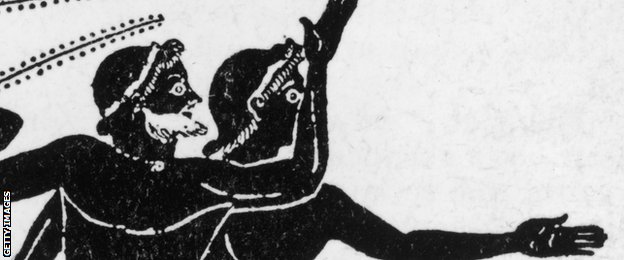The issue of doping in sport has been widely discussed in recent weeks, but … – BBC Sport
The issue of doping in sport has been widely discussed in recent weeks, but what exactly is it?
BBC Sport explains what it means, why it has become a hot topic, what the types of doping are and what is being done to tackle it.
What is doping?
Doping means athletes taking illegal substances to improve their performances.
There are five types of banned drugs, called doping classes.
The most common are stimulants and hormones. There are health risks involved in taking them and they are banned by sports’ governing bodies.
According to
the UK Anti-Doping Agency,
substances and doping methods are banned when they meet at least two of the three following criteria: they enhance performance, pose a threat to athlete health, or violate the spirit of sport.
What’s the history and why is it an issue now?
The use of stimulating substances in sport has been around for a long time, with Ancient Greek athletes known to have used potions to strengthen themselves.
During the 1920s it was felt restrictions about drug use in sport were necessary, and in 1928 the IAAF – athletics’ world governing body – became the first international sports federation to ban doping.

The use of stimulating substances in sport has been around since the Ancient Greeks
In 1966, the world governing bodies for cycling and football were the first to introduce doping tests in their respective world championships, with the first Olympic testing coming in 1968, at the Winter Games in Grenoble and Summer Games in Mexico. By the 1970s, most international federations had introduced drug-testing.
A major drug scandal
at the 1998 Tour de France
underlined the need for an independent international agency to set standards in anti-doping work. The World Anti-Doping Agency (Wada) was established the following year.
Cyclist Lance Armstrong
admitted to doping
in an interview with Oprah Winfrey in January 2013, was stripped of his seven Tour de France wins and banned from sport for life.
In December last year, a German TV documentary
alleged
as many as 99% of Russian athletes were guilty of doping, though the Russian Athletics Federation described the allegations as “lies”.
Since then, there have been numerous allegations of
doping in athletics.
What are people doping with?
The most commonly used substances are
androgenic agents
such as anabolic steroids. These allow athletes to train harder and build more muscle, but they can lead to increased aggression and kidney damage.
Other side-effects include baldness and low sperm count for men, and increased facial hair and deepened voice for women.
Anabolic steroids are usually taken either in tablet form or injected into muscles. Some are applied to the skin in creams or gels.
Then there are
stimulants
which make athletes more alert and can hide fatigue by increasing heart-rate and blood flow. But these are addictive and, in extreme cases, can lead to heart failure.
Diuretics
and
masking agents
are also used to remove fluid from the body, which can hide other drug use or, in sports such as boxing and horse racing, help competitors “make the weight”.

One type of doping is the use of erythropoietin (EPO), a hormone naturally produced by the kidneys
Narcotic analgesics
and
cannabinoids
can also be used. They mask pain caused by injury or fatigue – but can make injuries worse. They are also addictive. Products such as morphine and oxycodone are banned but codeine is allowed.
Then there are
peptide hormones.
These are substances such as EPO (erythropoietin) – which increases bulk, strength and red blood cells and gives athletes more energy – and HGH (human growth hormone), which builds muscle.
Less common is
blood doping,
where blood is removed from the body and injected back in to boost oxygen levels. This practice, which can lead to kidney and heart failure, is banned.
Glucocorticoids
mask serious injury because they are anti-inflammatories and affect the metabolism of carbohydrates, fat and proteins, and regulate glycogen and blood pressure levels.
Beta blockers,
meanwhile, are banned in sports such as archery and shooting because they keep the heart-rate low and reduce tremble in the hands.
A full list of banned substances in athletics can be found
on the IAAF website.
How is doping detected?

Blood samples, urine samples or both are taken from athletes in an effort to detect doping
Most testing for doping products uses a long-established technique called mass spectrometry.
This involves zapping urine samples with a beam of electrons that turns the atoms into charged particles.
As the scientists already know the weight of many steroids, for example, they are able to rapidly and accurately detect doping.
But there are difficulties with the system.
Some by-products of doping substances are so small they may not produce a strong enough signal for detection.
Blood testing is capable of detecting EPO and synthetic oxygen carriers, but not blood transfusions.
One method introduced to aid the detection of such transfusions is the
biological passport.
Brought in by Wada in 2009, the passport aims to reveal the effects of doping rather than detect the substance or method itself.
It is an electronic document about an athlete that contains certain markers from throughout their career. If these change dramatically, it alerts officials the athlete might be doping.
Some scientists have questioned the passport’s efficiency – especially when complicating factors such as training at altitude are factored in – but also its sensitivity to micro-dosing, a little-but-often approach to doping.
Famous doping cases

Please turn on JavaScript. Media requires JavaScript to play.
Ben Johnson stripped of Olympic gold in Seoul 1988
Prior to Armstrong’s confession, Ben Johnson was probably the world’s highest-profile drugs cheat. The Canadian sprinter tested positive for anabolic steroids at the 1988 Olympic Games in Seoul.
Johnson had won the 100m in a world record of 9.79 seconds but
was stripped of his gold medal
after the positive test and sent home in disgrace.
British sprinter Dwain Chambers
was banned from competition for two years
in 2004 after being found guilty of taking the anabolic steroid THG, while compatriot Linford Christie, a former sprint champion,
was suspended from athletics
in 1999 after failing a drugs test.
Other athletes to have been banned include US sprinters
Justin Gatlin
and
Marion Jones.
What next in the fight against doping?

New IAAF president Lord Coe has spoken of his determination to prove athletics has “zero tolerance” to doping
Former Olympic 1500m champion Lord Coe
was named the new president of the IAAF
on Wednesday and is determined to prove athletics’ world governing body is committed to ridding the sport of drug cheats.
Coe, who has been a strong defender of the IAAF’s record, has pledged to set up an independent anti-doping agency for the sport, admitting there is a perception that in-house drug-testing creates “conflicts” and “loopholes”.
“There is a zero tolerance to the abuse of doping in my sport and I will maintain that to the very highest level of vigilance,” he said.
Meanwhile, the UCI – cycling’s world governing body –
introduced 24-hour testing earlier this year.
Previously there was no testing between 11pm and 6am, providing a potential window of opportunity for micro-dosing products, such as EPO, without being caught.
Stricter punishments approved by Wada came into effect in January, doubling bans for athletes found guilty of doping from two years to four.
Sir Craig Reedie, Wada’s president, believes more can be done, urging governments to criminalise doping
and suggesting
a blanket ban on countries whose athletes regularly dope could be introduced.



